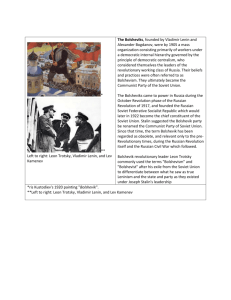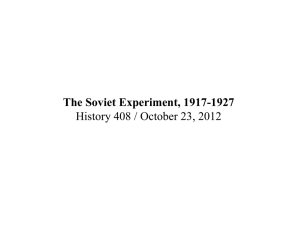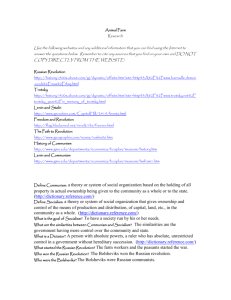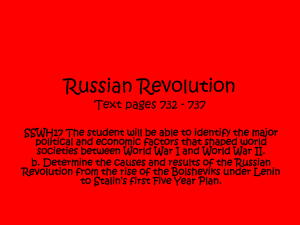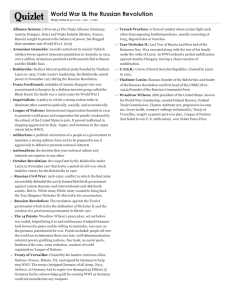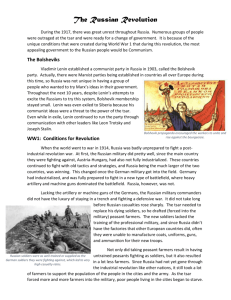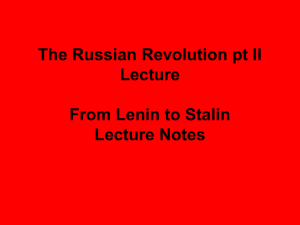The Red Cavalry
advertisement
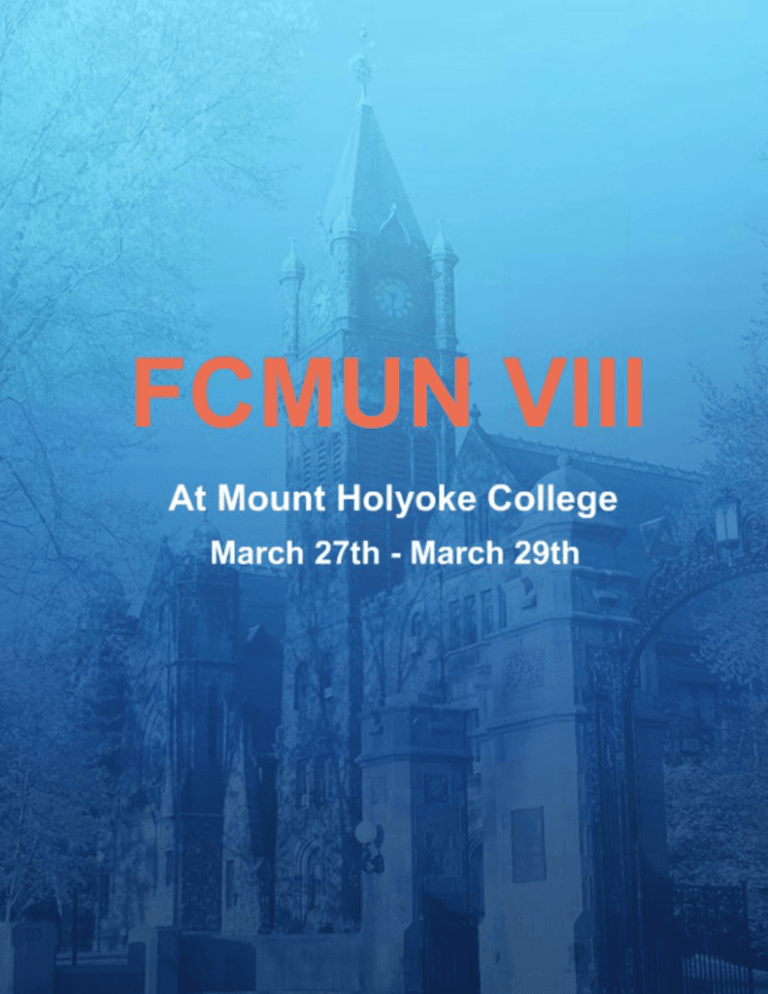
The Red Cavalry: Russian Civil War Letter from the Director: Dear Delegates, Welcome to FCMUN, and welcome especially to the Red Cavalry: Russian Civil War. My name is Nicole Daphnis and I will be your crisis director for what is sure to be an excellent committee. Originally from the lovely (and relevant to Russian history) little town of Portsmouth, New Hampshire, I am a first year at Mount Holyoke College, planning on double majoring in Russian and Eurasian Studies and Politics. This is my first year doing MUN and I can’t wait to experience a crisis committee from the back room. The intention of this committee is to bring you back to a very controversial time in Russian and Soviet history. The Soviet period in general, and of course the Civil War, is shrouded in many layers of historical revisionism, and it is often very difficult to make sense of what actually happened and why. For that reason, innovative solutions to the many problems of the war are highly encouraged. As members of the Bolshevik Party, which gained power mere months before the catalyst of the outbreak of civil war, you many have substantial issues to tackle. Firstly, there is the actual war, a monster of its own kind. Secondly, there is the question of how to maintain Bolshevik power and how to form this new Soviet Republic, and thirdly there is the ever-controversial component of dealing with party politics. I am incredibly excited to run this committee, and I am looking forward to meeting you all and seeing what you come up with in the committee room. If you have any questions, don’t hesitate at all to be in touch with me at: daphn22n@mtholyoke.edu. Sincerely, Nicole Daphnis Crisis Director of the Red Cavalry: Russian Civil War Structure Committee Structure: Delegates represent leading members of the Bolshevik Party, all with their own unique roles to keep the Party functioning. The Bolsheviks operate under MarxistLeninist ideology and recently took power from the Provisional Government on October 25th, 1917 (Julian or Old Style calendar. Dates from 1918 onward will be written in the Gregorian or New Style calendar). Upon seizing power, the Bolsheviks formed the Russian Soviet Federative Socialist Republic (RSFSR), the precursor to what will become the Soviet Union in 1922. The timeline of the committee will begin on March 4th, 1918, the day after the signing of the Treaty of Brest-Litovsk, which ended Russia’s participation in World War I. This treaty is highly controversial and results in the consolidation of certain antiBolshevik forces, as well as a loss of public support for the Bolsheviks. Parliamentary Procedure: Though debate in the committee room will primarily function in moderated caucuses, unmoderated caucuses are highly recommended when planning any major military or political operations. Points of information are encouraged at the end of each crisis so that there is no confusion in the committee. In the true spirit of Marxism, voting status will be extended equally to all present members of the committee. All press releases and action orders must be voted on, with a simple majority required to pass. Delegates may write private, individual communiqués to members of the Party or to other contacts. Delegates may also motion to introduce a document, move into voting procedure on a specific document, propose an amendment (to a document that is being debated but has not yet been voted upon), and move into an unmoderated caucus, with a specific time and purpose. All motions must be voted upon. The chair will make sure that when a motion to move into voting procedure passes, the committee will move directly into voting on the specific document. Timeline: Each committee will encompass roughly one year, thus the committee will end approximately in the spring of 1922. The Bolshevik Party The origins of the Bolshevik Party lie in 1903, when Lenin decided to split off from the Russian Social Democratic Labour Party (RSDLP) and form a revolutionary party of his own. Lenin’s concern was that not all those in the Social Democrat party were fully dedicated to the revolution, and thus his aim was to create a smaller, more tightly knit party in which all members were completely active in revolutionary activity. The name Bolshevik comes from the Russian word for “majority,” and despite promoting the supposed interest of the masses, the Party never actually had the mass support. What ultimately set them apart and allowed them to take control was their superior organization and brute force. In this way, it was a smart move for Lenin to form his own smaller party, as it allowed for him to have more control over its actions and also for easier communication and organization. Ideologically, the Bolshevik party aims to enact Marxism-Leninism. Despite the term Marxism-Leninism itself not being coined by Stalin until after Lenin’s death, Lenin had been making substantive critiques and amendments and critiques to orthodox Marxism since 1902, when he published his famous treatise, What Is to Be Done? The main tenants of Leninism can be found in this short piece, such as vanguardism, and the argument that the working class will not become political just by fighting economic battles. At the start of the committee, the Bolshevik Party holds 60% of seats at the AllRussian Congress of Soviets, the main democratic governing body. Given the Bolsheviks’ precarious position both internally within the government as well as externally throughout the country, with various anti-Bolshevik movements consolidating, maintaining power and support will be a big concern of the committee. History Behind the War The events and causations of the Civil War are complex, often disputed, and date back to 1861, when serfdom was abolished in the Russian Empire and what could be considered modern capitalism was introduced. Laid out simply, Russia’s evident decline begins when Tsar Nicholas II takes the throne in 1894. Like Louis XVI before him, Nicholas II knew upon the day of coronation that he was not fit to rule the massive Russian Empire. Vasily Kliuchevsky, a leading historian accurately predicted in 1895 that, “The Romanov Dynasty will end with Nicholas II. If he has a son, the son will not reign.” Nicholas the II was primarily a father, not a statesman, and it was sheer dedication to God that caused him to be a passive ruler, always believing that in times of hardship God was on Russia’s side, and as a result was known for being indecisive in taking action on virtually anything. By the time Nicholas II ascended the throne, Marxism had already taken a strong foothold in the two most industrialized cities, Moscow and Saint Petersburg, which was then the capital. (A fault of both Imperial Russia and the early Soviet governments was that most of the country was heavily disconnected from what went on in these two cities.) Those who would become major figures such as Lenin, Trotsky, and Stalin, were already making their mark and taking action. The Mensheviks, the most prominent communist opposition to the Bolsheviks, taking their name from the Russian word for minority, as well as revisionist historians, believed however that Russia was not “ready” for revolution. They thought that overthrowing the monarchy now would not allow for capitalism to flourish sufficiently, as traditional Marxism supposedly called for before enacting revolution. This critique says that without a certain period of capitalism, there would not enough commodities produced for an effective redistribution of wealth. However, this argument was not stopping Lenin’s determination. He saw the obvious weakness in Imperial Russia as a ripe opportunity, and would industrialize the whole of Russia under his own terms post-revolution. Come 1905, Russia faces an embarrassing defeat in the Russo-Japanese War, the peace treaty for which had to be orchestrated by US President Theodore Roosevelt in Portsmouth, New Hampshire. Due to high death tolls for Russia and the sheer gruesomeness of the war, the average Russian’s frustration with the imperial government threatened to boil over. And it did, to an extent. The 1905 Revolution in Russia was triggered on January 22nd, when unarmed protestors in Saint Petersburg, carrying icons and singing patriotic songs, marched towards the Tsar’s palace to present him a petition regarding worker’s rights, were gunned down by palace guards, killed with sabers, as well as trampled by horses. Naturally, Bloody Sunday causes an outcry. Protests erupt across the empire from the Baltics to Baku. Along with workers’ rights, issues of Russia’s inefficient agrarian system and the institutionalized oppression of ethnic minorities also fueled the 1905 Revolution. The protests continued through October, when Nicholas II conceded defeat and presented his October Manifesto, which would proclaim the Russian Empire a now limited constitutional monarchy. Along with establishing basic rights for the average citizen, the October Manifesto also instituted the State Duma (parliament). Despite his best efforts to try and democratize his country, Nicholas II ultimately had the power to disband and reform the Duma at his whim, and rendered it ineffective by doing so whenever he didn’t like what they produced. What really pushed the Russian Empire over the edge, however, was World War I. Originally anticipated to be a six-month skirmish, this conflict dragged Russia into the worst war the world had seen, and it effectively tore the motherland apart. Unparalleled mass-demonstrations and violent armed conflict with the police broke out in Saint Petersburg, renamed Petrograd during the wartime, in early 1917. What became the February Revolution lasted only a week. Petrograd fell into violent chaos, and Tsar Nicholas II abdicated the throne, to be replaced by the Russian Provisional Government. The Provisional Government was an alliance between liberals and socialists. However, during the February Revolution Lenin was exiled in Sweden, and thus the Bolsheviks had little to do with the February Revolution. Lenin returned to Russia as soon as possible, and upon arriving issued his April Theses, which condemned the Provisional Government as bourgeois and laid the ideological framework for the October Revolution. It was at this point that Lenin was able to consolidate his power, not only rallying for public support, but also gaining strong allies. Many returning from exile such as Lev Kamenev switched to the Bolshevik Party, and Leon Trotsky, formerly Lenin’s biggest critique, left the Menshevik Party for the Bolshevik. While the Provisional Government was stumbling to figure out how to function, Lenin, a brilliant orator and organizer, revolutionized urban workers into councils and bolstered widespread support across the country. After months of frustration with the Provisional government, including peasant uprisings and massive workers demonstrations, the time was ripe for Red October. On the night of October 25th, though small in number, the Bolsheviks effectively stormed the Winter Palace where the Provisional Government had been operating, and seized power by the end of the night. Similar uprisings broke out all over Russian territory in the coming days and months, as well as anti-Bolshevik backlash. In forming his new country, Lenin found it crucial to pull out of the World War. This lead to the signing of the Treaty of Brest-Litovsk, which was highly controversial as Russia seceded over one million square miles of territory, 60 million citizens, as well as vital natural resources and farmland. Lenin lost a great deal of public support after this, though it was necessary to preserve Bolshevik power. Though many Russians saw the treaty as a defeat, Lenin realized that a continued war effort would only weaken Russia, a fledgling country under an entirely new political system, which needed to strengthen itself from the inside out. It is with the Treaty of Brest-Litovsk that anti-Bolshevik movements really gain momentum. The main force opposing Bolshevik authority included the White Army, a nationalistic, monarchist force comprising of former Tsarist military figures. Politically, the White Army varied significantly, and was only unified by their anti-Bolshevism. They operated on the Southern front, Eastern Siberian front, and the Northern fronts. Also notable is the Green Army, were armed peasant groups aimed at protecting their own communities. There were also a number of other ethnic and regional-based antiBolshevik forces. The following is a map of established Bolshevik territory and the direction of antiBolshevik forces: Positions Vladimir Ilyich Lenin: Born Vladimir Ilyich Ulyanov on April 22nd, 1870 to a recently noble family, Lenin grew up in a very conservative, monarchist household in Simbirsk. However, upon the death of his father when he was 16, Lenin denounced his belief in God, and reportedly had strange behavior. The following year, as Lenin was preparing to enter Kazan University for law, his older brother Aleksandr was executed for involvement in a failed assassination attempt on Tsar Alexander III. It was at this point in which Lenin first began taking interest in his brother’s radical ideas. Throughout his time at university, Lenin was active in different illegal leftist organizations, for which he was eventually expelled. His interest in Marxism grew upon discovering Das Kapital. In 1890, his mother convinced the authorities to allow Lenin to take his law exams at a university of his choice, and thus he obtained a first-class degree with honors from the University of Saint Petersburg. During the 1890s, Lenin spent much time studying economics and leftist theory, eventually rising to a senior position in the budding Social Democrat party. In 1897 he was exiled for three years in Siberia, after which he founded his famous newspaper Iskra, or Spark. He took the name Lenin in 1901, and spent 1902 onwards strengthening his newly founded Bolshevik Party and was also involved in socialist activity abroad. He returned to Russia following the 1905 Revolution, however by 1908 had left for Europe again. He altogether missed the February Revolution in 1917, having been exiled to Zurich, and returned to Russia in April. A brilliant orator and organizer, Lenin went to work strengthening his Bolshevik Party for their own revolution. Lev (Leon) Davidovich Trotsky: Originally named Lev Davidovich Bronstein, Trotsky was born on October 26th, 1879 to a Jewish, though not very religious, family in Yanovka, Ukraine. At age eight Trotsky was sent to a German, later Russified, school in Odessa, and afterword went to Nikolayev. It was here at age 17 that he first became exposed to Marxism. Abandoning a degree in mathematics, Trotsky then began to put his full effort into political work, publishing leaflets and organizing industrial workers. In 1898 he was arrested and spent two years in prison awaiting trial. Trotsky was sent to four years of exile in Siberia, where he focused on studying philosophy and began writing for Lenin’s paper Iskra. He escaped Siberia halfway through this sentence in 1902 and relocated to London, where he met Lenin and other editors of Iskra. In 1902 he also adopted the name Trotsky from one of his old jailers. In 1903 Trotsky had a split with Lenin, joining the Mensheviks, and was Lenin’s biggest critic for a long while. Trotsky also returned to Russia post-1905 Revolution, writing leaflets and urging the Mensheviks to further radicalize, however he was betrayed to the secret police and fled to Finland. Similarly to Lenin, Trotsky spent most of the time leading up to the October Revolution abroad. He returned to Russia in May of 1917, and converted to the Bolshevik Party in July. He made reparations with Lenin and quickly rose to second in command in the Bolshevik ranks. After the Bolsheviks came to power, Trotsky became the People’s Commissar for Foreign Affairs and led the Soviet delegation in the Treaty of BrestLitovsk. Just before the treaty he also became head of the Red Army. Iosif (Joseph) Vissarionovich Stalin: Stalin’s childhood was marked by a violently abusive alcoholic father, poverty, smallpox, and two instances of being run over by a horse-drawn carriage. Born Ioseb Besarionis dze Jughashvili in Gori, Georgia, on December 6th, 1878, Stalin at age ten received a scholarship to the Gori Theological School, and there flourished. He received top marks, was an excellent singer, and began to write poetry, for which he gained some fame. At age 15 he enrolled at the Orthodox Seminary of Tiflis on scholarship. Many seminary students were drawn to forbidden books such as Victor Hugo novels and Marxist literature. Shortly before final exams, the Seminary raised their fees, and Stalin was forced to quit. He quickly became active in politics, joining the Bolshevik Party in 1902, and in 1905 was elected to represent the Caucasus at the next Bolshevik conference. Stalin first met Lenin in 1906. In 1907, Stalin organized a robbery of the Imperial Bank in Tiflis, funding the Bolshevik Party with 341,000 rubles (modern US $3.4 million). He started using the name Stalin, roughly ‘man of steel’ in Russian, between 1910-12. He continued to be very active in revolutionary activity, also becoming editor in chief of the newspaper Pravda (Truth), but was forced to spend much time in hiding from the secret police. Stalin was released from exile upon the 1917 February Revolution and became closer to Lenin, however with some disagreements. He helped Lenin organize the October Revolution and was directly involved in the takeover of the Winter Palace. Mikhail Ivanovich Kalinin: Kalinin was born on November 7th, 1875, in the village of Verkhanyaya Troitsa, 226 kilometers north of Moscow. He finished his education at a local school at age 14, after which he worked on a farm for some time, eventually moving to Tiflis as a railway worker. In Tiflis Kalinin got to know Stalin and also joined the RSDLP upon its foundation. In 1905 he began working for the Bolshevik party and remained a devoted member. Kalinin was arrested in 1916 but was released in 1917 after the February Revolution. Kalinin assisted in the organization of Pravda and, at odds with Lenin, advocated for conditional support of the Provisional Government, an opinion shared by the Mensheviks. In autumn of 1917, Kalinin was chosen as mayor of Petrograd, a positioned he maintained after the Bolshevik Revolution. Nikolai Ivanovich Bukharin: Born on the 27th of September, 1888, Bukharin was the son of two schoolteachers, and eventually went on to receive education at Moscow University. It was at university that he first became involved in politics, participating in student demonstrations related to the 1905 Revolution. In 1906, Bukharin joined the Bolshevik Party, and in 1907 headed the national youth conference in Moscow, which was later considered to be the founding of Komsomol (the communist youth league). Bukharin first met Lenin in 1912 in Krakow, where he continued his education as well as publishing several books, establishing himself as a major Bolshevik theorist. Returning to Russia in April of 1917, Bukharin was very active in the October Revolution, drafting and introducing the decrees of the Moscow Soviet. He also became editor of Pravda. That being said, Bukharin was also a firm believer of world revolution, firmly opposing Lenin’s decision to sign the Treaty of Brest-Litovsk, thinking that the continuation of war would incite further revolution in European countries. Lev Borisovich Kamenev: Born on July 6th 1883, originally of the surname Rozenfeld, Kamenev was the son of a Jewish father and Russian Orthodox mother. Kamenev’s parents had ample funding his education, having attended the boys’ Gymnasium in Tiflis, and later Moscow University. However in 1902 Kamenev’s education was interrupted with an arrest, after which he became a professional revolutionary. Kamenev supported Lenin since 1901, and in these early years also married Trotsky’s sister, Olga. Kamenev was able to be involved the 1905 Revolution, and afterwards went back and forth from Europe multiple times to attend RSDLP congresses. In 1910 he was also involved in the attempted reunification of Bolshevik and Menshevik parties, however this failed. Kamenev eventually had a serious falling out with Lenin as one of two Central Committee members to vote against an armed revolt in October, and later after the Revolution having called for shared power with other socialist parties to ensure loyalty. Lenin branded him a “deserter.” Despite this spat, Kamenev became chairman of the Moscow Soviet in 1918. Vyacheslav Mikhailovich Molotov: Molotov was born Vyacheslav Mikhailovich Skryabin, unrelated to the composer of the same surname, on February 25th, 1890, to a shop clerk in the village of Kukarka, 258 kilometers north of Kazan. In Molotov’s youth he was known for his shyness, as well as assisting his father with his business. He first attended a secondary school in Kazan, and joined the RSDLP, siding with Lenin and the Bolsheviks. In 1909 he was arrested and spent two years exiled in Vologda, and around this time took the name Molotov, from the Russian word for hammer. In 1911 he enrolled at Saint Petersburg Polytechnic, while also on the editorial staff for Pravda. Molotov also met Stalin for the first time, though briefly, and they did not have a close relationship. Molotov was one of the few prominent Bolsheviks in Saint Petersburg for the February Revolution, and immediately pushed to Pravda to the left in opposition of the Provisional Government. Molotov became a close ally and follower of Stalin upon his return to Russia. He was a member of the Military Revolutionary Committee, which organized the October Revolution, and in 1918 was sent to Ukraine to deal with the outbreak of civil war. Kliment Yefremovich Voroshilov: Born February 4th, 1881, Voroshilov grew up in Verkhnye, Ukraine, not far from the Russian border, into an ethnically Russian family of railway workers. He joined the Bolsheviks in 1905, and after the October Revolution became a member of the Ukrainian Council of People’s Commissars, as well as Commissar for Internal Affairs. He has aided Stalin in the Military Council, led by Trotsky, and is an active commander of the Southern Front in the 1st Cavalry Army. Felix Edmundovich Dzerzhinsky: Dzerzhinsky was born on an estate about 70 kilometers outside of Minsk on August 30th, 1877. His family belonged to former Polish nobility and as a child Dzerzhinsky considered becoming a Jesuit priest. His father died when he was five. During his school days, Dzerzhinsky attained fluency in Polish, Russian, Yiddish, and Latin. However, Dzerzhinsky was expelled from gymnasium two months before graduating due to having joined a Marxist group. By the end of 1905 Dzerzhinsky played a central role in the RSDLP, and like many revolutionaries spent his time in multiple exiles and was on the run from the police. Dzerzhinsky was released from prison in Russia following the February Revolution, and at first intended to help organize revolution in Poland, however he stuck with the Bolshevik Party, finding it to be the only socialist party really representing the proletariat. In July Dzerzhinsky was voted into the Central Committee, and in December was appointed director of the Cheka, Lenin’s new secret police force. Dzerzhinsky initially opposed the signing of the Treaty of Brest-Litovsk. Grigory Yevseevich Zinoviev: Originally named Ovsei-Gershon Aronovich Radomyslovsky Apfelbaum, Zinoviev was born on September 11th, 1883, to dairy farmers in Ukraine. He joined the RSDLP in 1901 and was a member of the Bolshevik Party since its inception. He quickly rose within the Party ranks, being voted into the Central Committee in 1907, and was very close with Lenin. Zinoviev returned to Russia with Lenin after the February Revolution, however the two had a falling out as Zinoviev opposed a coup against the Provisional Government. He, along with Kamenev, was the only two to vote against it. Further conflict with Lenin ensued, as Zinoviev also agreed with Kamenev on appealing to other socialist parties for loyalty. Despite at one point resigning from the Central Committee with Kamenev, Zinoviev returned to the Central Committee in early March of 1918, and was put in charge of Petrograd and its regional government. Semyon Mikhailovich Budyonny: Budyonny was born on April 13th, 1883, in the Don region of southern Russia. Budyonny had worked as a farm laborer until 1903, when he was drafted into the Imperial Russian Army. He served in the Russo-Japanese war as well as on the Western Front of World War I, becoming famous for military courage and leading a number of victories. After the February Revolution Budyonny was radicalized along with other soldiers, and became a prominent member of the soldier’s Soviet in the Caucuses region. In 1918, Budyonny organized a Red Cavalry force in the Don region, which later became the 1st Cavalry Army. Nikolai Nikolayevich Krestinsky: Krestinsky was born on October 13th, 1883, in Mogilev, Belarus. Though presumed Russian, his ethnic and religious origins are disputed. Krestinsky joined the RSDLP in 1903 and immediately sided with the Bolsheviks. He was a dedicated member of the party, working as an organizer, and was voted into the Central Committee in August of 1917. Krestinsky had supported Trotsky in the signing of the Treaty of BrestLitovsk. Potential Topics The war effort: Bolshevik control of Russia at this time is precarious at best. The Bolshevik Party will have to maintain its territory, which is being attacked on multiple fronts. Managing the new Soviet Republic: The world has never seen anything remotely resembling a Marxist-oriented government, and the spotlight is on the Bolshevik Party to pull it off well. Anti-Bolshevik sentiment exists everywhere in Russia, and the Party will have to make sure they can diminish that and maintain control of power. Party politics: Unfortunately, the Bolshevik Party is not beyond the sort of competition for power within the party that comes with politics in general. It is evident that certain members of the Party are trying to get as close to Lenin as possible, and these individuals have their own allies and resources within the Party. Sources A People’s Tragedy: The Russian Revolution 1891-1924 – Orlando Figes The Soviet Colossus: History and Aftermath – Michael Kort What Is to Be Done? – Vladimir Lenin The Russian Civil War – Evan Mawdsley Young Stalin – Simon Sebag-Montefiore Three “Whys” of the Russian Revolution – Richard Pipes My Life: An Attempt at an Autobiography – Leon Trotsky

